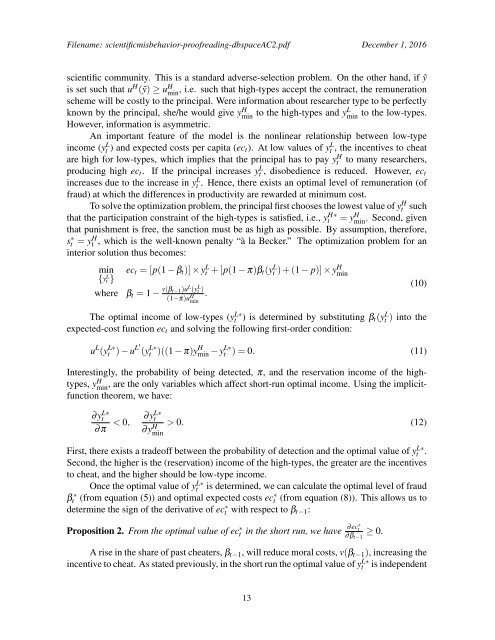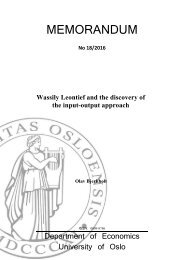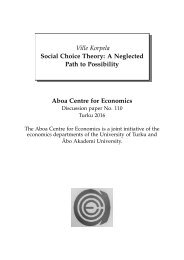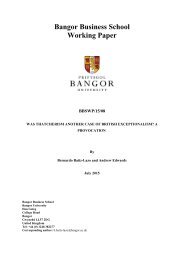Cheat Perish? A Theory Scientific Customs
n?u=RePEc:tut:cccrwp:2016-03-ccr&r=hpe
n?u=RePEc:tut:cccrwp:2016-03-ccr&r=hpe
Create successful ePaper yourself
Turn your PDF publications into a flip-book with our unique Google optimized e-Paper software.
Filename: scientificmisbehavior-proofreading-dbspaceAC2.pdf December 1, 2016<br />
scientific community. This is a standard adverse-selection problem. On the other hand, if ỹ<br />
is set such that u H (ỹ) ≥ u H min<br />
, i.e. such that high-types accept the contract, the remuneration<br />
scheme will be costly to the principal. Were information about researcher type to be perfectly<br />
known by the principal, she/he would give y H min to the high-types and yL min<br />
to the low-types.<br />
However, information is asymmetric.<br />
An important feature of the model is the nonlinear relationship between low-type<br />
income (yt L ) and expected costs per capita (ec t ). At low values of yt L , the incentives to cheat<br />
are high for low-types, which implies that the principal has to pay yt<br />
H to many researchers,<br />
producing high ec t . If the principal increases yt L , disobedience is reduced. However, ec t<br />
increases due to the increase in yt L . Hence, there exists an optimal level of remuneration (of<br />
fraud) at which the differences in productivity are rewarded at minimum cost.<br />
To solve the optimization problem, the principal first chooses the lowest value of yt<br />
H such<br />
that the participation constraint of the high-types is satisfied, i.e., yt<br />
H∗ = y H min<br />
. Second, given<br />
that punishment is free, the sanction must be as high as possible. By assumption, therefore,<br />
st ∗ = y H t , which is the well-known penalty “à la Becker.” The optimization problem for an<br />
interior solution thus becomes:<br />
min<br />
{y L t }<br />
ec t = [p(1 − β t )] × y L t + [p(1 − π)β t (y L t ) + (1 − p)] × y H min<br />
where β t = 1 − v(β t−1)u L (yt L )<br />
.<br />
(1−π)u H min<br />
The optimal income of low-types (yt<br />
L∗ ) is determined by substituting β t (yt L ) into the<br />
expected-cost function ec t and solving the following first-order condition:<br />
u L (y L∗<br />
t<br />
(10)<br />
) − u L′ (yt<br />
L∗ )((1 − π)y H min − yL∗ t ) = 0. (11)<br />
Interestingly, the probability of being detected, π, and the reservation income of the hightypes,<br />
y H min<br />
, are the only variables which affect short-run optimal income. Using the implicitfunction<br />
theorem, we have:<br />
∂y L∗<br />
t<br />
∂π < 0,<br />
∂yt<br />
L∗<br />
∂y H > 0. (12)<br />
min<br />
First, there exists a tradeoff between the probability of detection and the optimal value of yt L∗ .<br />
Second, the higher is the (reservation) income of the high-types, the greater are the incentives<br />
to cheat, and the higher should be low-type income.<br />
Once the optimal value of yt<br />
L∗ is determined, we can calculate the optimal level of fraud<br />
βt<br />
∗ (from equation (5)) and optimal expected costs ect ∗ (from equation (8)). This allows us to<br />
determine the sign of the derivative of ect ∗ with respect to β t−1 :<br />
Proposition 2. From the optimal value of ec ∗ t in the short run, we have ∂ec∗ t<br />
∂β t−1<br />
≥ 0.<br />
A rise in the share of past cheaters, β t−1 , will reduce moral costs, v(β t−1 ), increasing the<br />
incentive to cheat. As stated previously, in the short run the optimal value of yt<br />
L∗ is independent<br />
13





